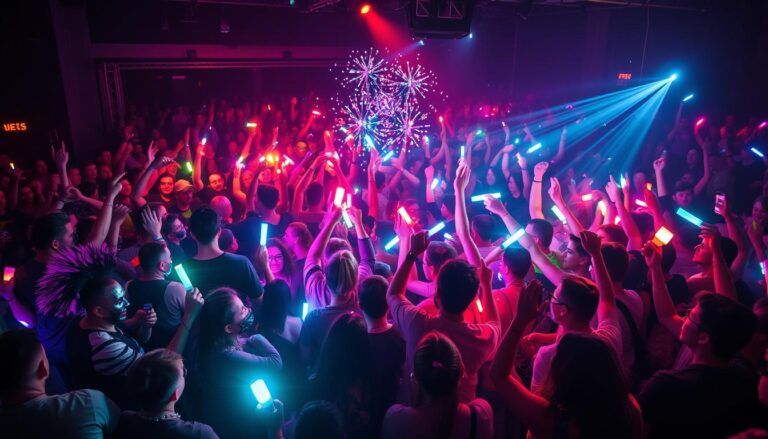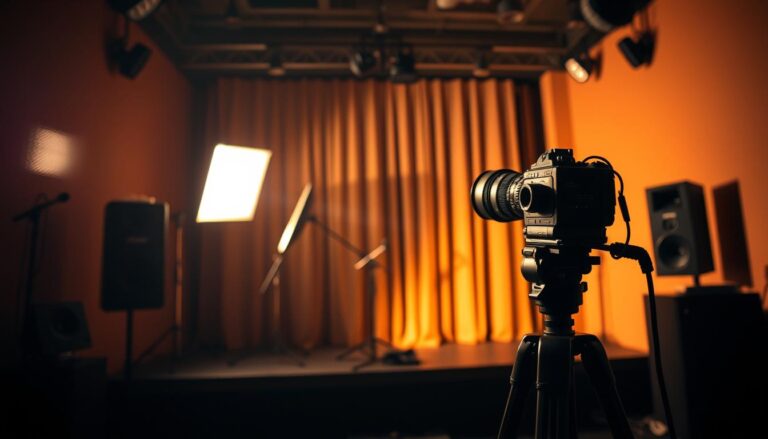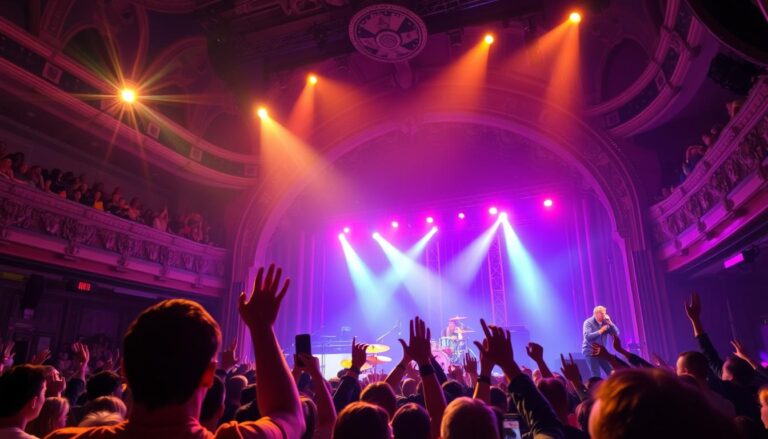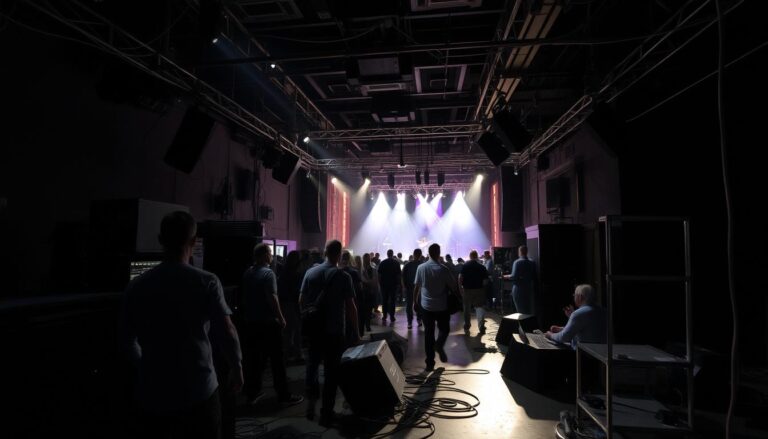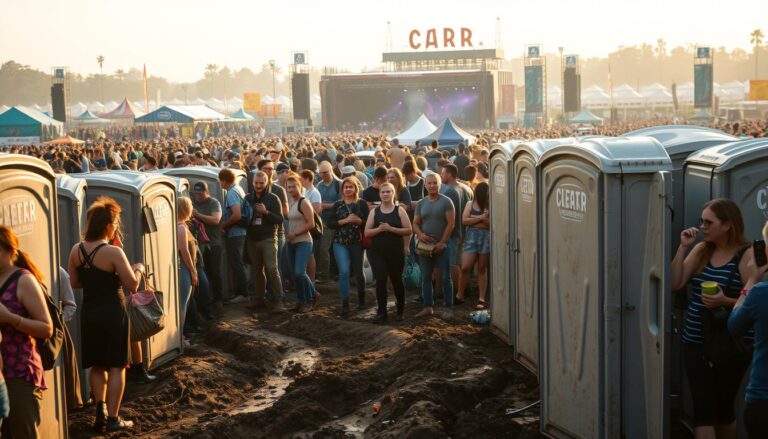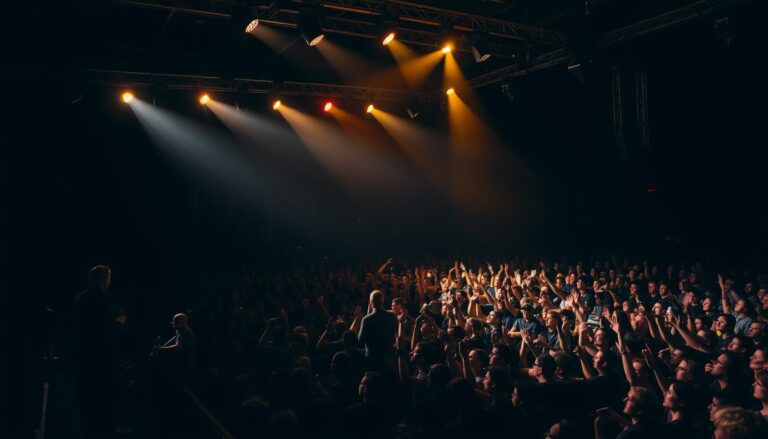The thrill of a live concert is an experience like no other, but have you ever wondered what goes on behind the scenes before the lights go on? The concert setup is a complex process, with soundchecks playing a crucial role in ensuring the show goes off without a hitch.
A soundcheck is more than just a technical necessity; it’s an art form that requires precision and attention to detail. It involves a series of tests to ensure that the sound system is working perfectly, and that the artists are happy with their monitor mixes.
By understanding how soundchecks really work, we can appreciate the effort that goes into creating an unforgettable live music experience.
Key Takeaways
- Soundchecks are a critical part of the concert setup process.
- A thorough soundcheck ensures the sound system is working perfectly.
- Artists rely on soundchecks to get their monitor mixes just right.
- A good soundcheck is essential for a great live music experience.
- The concert setup involves a lot of behind-the-scenes work.
The Critical Pre-Show Ritual
Before the lights go on and the crowd erupts, there’s a crucial ritual that ensures the show goes off without a hitch. This ritual, known as the soundcheck, is a vital part of any live performance. It sets the stage for an unforgettable experience, not just for the audience, but also for the artists performing.
Why Soundchecks Matter to Both Artists and Audience
Soundchecks are essential for both the artists and the audience. For artists, a thorough soundcheck ensures that their performance sounds great, boosting their confidence on stage. According to Rachel Louise, a renowned artist, “A good soundcheck is like a warm-up for the performance; it gets us ready to deliver our best.” For the audience, a soundcheck guarantees a high-quality audio experience, making the event more enjoyable.
The importance of soundchecks cannot be overstated. It’s not just about making sure the equipment is working; it’s about creating an immersive experience. As Kylie Price, another artist, noted, “A soundcheck is crucial; it’s when we get to fine-tune our sound to match our vision for the performance.”
The Typical Timeline of a Professional Soundcheck
A professional soundcheck typically follows a structured timeline. It begins with a line check to ensure all equipment is functioning correctly, followed by instrument checks and balancing. The sound team then conducts a vocal microphone setup and testing, culminating in a full band run-through. This process can take anywhere from a few hours to a full day, depending on the complexity of the performance.
The timeline may vary, but the goal remains the same: to deliver a flawless performance. As seen in the image below, a soundcheck involves meticulous planning and execution.
Load-In: Where It All Begins
The load-in process is the initial step in transforming an empty venue into a live performance space. It’s a critical phase that sets the stage for a successful concert, involving the transportation and setup of equipment, stage construction, and preparation of the venue.
The Logistics of Equipment Arrival
The logistics of equipment arrival is a complex task that requires meticulous planning. Tour managers and production teams work together to coordinate the transportation of equipment, ensuring that everything arrives at the venue on time. This includes sound and lighting equipment, stage risers, and backline gear. The crew then begins unloading the equipment, sorting and organizing it for setup.

Setting Up the Stage: From Empty Space to Performance Ready
Once the equipment has arrived, the stage setup begins. This involves constructing the stage, setting up sound and lighting systems, and positioning the backline gear. The crew works efficiently to transform the empty space into a performance-ready area. The stage setup is a critical aspect of the load-in process, as it provides the foundation for the soundcheck and ultimately, the concert itself.
Australian Venue Peculiarities: From the Corner Hotel to the Sydney Opera House
Australia’s diverse venues present unique challenges for the load-in process. From intimate spaces like The Corner Hotel in Melbourne to iconic venues like the Sydney Opera House, each location requires adaptability and expertise. The crew must be familiar with the venue’s layout, acoustics, and logistical requirements to ensure a smooth load-in and successful concert.
The Technical Team Behind Every Great Show
When the lights go on and the music starts, it’s not just the artists who are working hard – a dedicated technical team is behind every great show. This team is responsible for ensuring that every aspect of the concert, from sound to lighting, runs smoothly.
Key Personnel and Their Roles
The technical team is led by the Front of House (FOH) Engineer, who is responsible for the overall sound quality during the performance. Other key personnel include the Monitor Engineer, who handles the mix for the performers on stage, and the Lighting Designer, who creates the visual atmosphere of the show.
The team also includes Stagehands, who are crucial for setting up equipment, and Backstage Coordinators, who ensure that everything runs on schedule. Each member of the team plays a vital role in the success of the concert.
| Role | Responsibility |
|---|---|
| Front of House (FOH) Engineer | Overall sound quality |
| Monitor Engineer | Mix for performers |
| Lighting Designer | Visual atmosphere |
Communication Systems and Protocols
Effective communication is crucial during a concert setup and performance. The technical team uses intercom systems to stay in touch with each other, ensuring that any issues are addressed quickly.
Clear protocols are also established for soundchecks and emergency procedures, ensuring that everyone knows their role in case of an issue. This level of preparedness is what makes a concert truly memorable.
How Soundchecks Really Work: The Step-by-Step Process
The step-by-step soundcheck process is a behind-the-scenes magic that makes the show happen. It’s a meticulous ritual that involves several critical checks to ensure that every aspect of the performance sounds perfect to the audience.
Line Checks and System Calibration
The soundcheck begins with line checks and system calibration. This involves testing each component of the sound system to ensure it’s functioning correctly. The sound engineer checks every cable, connector, and device in the signal chain, from the microphones to the speakers. System calibration is crucial as it ensures that the sound system is optimized for the venue’s acoustics.
Calibration involves adjusting the sound system’s parameters to match the venue’s characteristics, such as reverberation time and sound reflections. This step is vital for achieving high-quality sound that is clear and enjoyable for the audience.
Instrument Checks and Balancing
Once the sound system is calibrated, the next step is to check and balance the instruments. This involves testing each instrument’s sound level, tone, and overall quality. The sound engineer works closely with the musicians to ensure that their instruments are sounding their best. Balancing the instruments is crucial to achieve a harmonious mix where every element can be heard clearly.
The sound engineer adjusts the gain levels, EQ settings, and compression ratios to optimize the sound of each instrument. This process requires a good understanding of the music and the preferences of the performers.
Vocal Microphone Setup and Testing
Setting up and testing vocal microphones is a critical part of the soundcheck. The sound engineer selects the appropriate microphones for the vocalists and positions them for optimal sound capture. Testing involves checking for sound quality, feedback, and bleed from other instruments.

Full Band Run-Through
The final step is a full band run-through, where the entire band plays together. This allows the sound engineer to fine-tune the mix, making adjustments as needed to achieve a balanced sound. The run-through also gives the band a chance to get comfortable with the sound and feel of the venue.
During the run-through, the sound engineer pays attention to the overall mix, making sure that every element of the band’s performance is well-balanced and sounding great. This is the last check before the show begins, ensuring that the audience will enjoy a high-quality performance.
Monitor Mixes: The Artist’s Perspective
For performers, a good monitor mix is crucial, and sound engineers work closely with them to ensure they hear exactly what they need to. A well-crafted monitor mix can make a significant difference in the quality of the performance.
In-Ear Monitoring vs. Floor Wedges
The debate between in-ear monitoring and floor wedges has been ongoing in the live sound industry. In-ear monitoring provides a more controlled and isolated listening experience, allowing artists to hear their mix clearly amidst the loud stage sound. On the other hand, floor wedges offer a more traditional approach, where the mix is directed towards the performers through speakers on the stage.
According to insights from artists like Rachel Louise and Kylie Price, the choice between in-ear monitoring and floor wedges often comes down to personal preference and the specific needs of the performance. Some artists prefer the flexibility and clarity of in-ear monitoring, while others like the more natural listening experience provided by floor wedges.
Creating the Perfect Mix for Performers
Creating the perfect monitor mix involves a deep understanding of the artist’s needs and preferences. Sound engineers work closely with performers to tailor the mix to their specific requirements, taking into account factors such as the type of music, the size of the venue, and the artist’s personal preferences.
The process involves a combination of technical expertise and artistic judgment. By using a combination of digital signal processing and real-time adjustments, sound engineers can create a monitor mix that enhances the performer’s ability to deliver a great show.
Ultimately, a great monitor mix is essential for a successful live performance, and the collaboration between sound engineers and artists is crucial in achieving this goal.
Front of House Engineering: Crafting What the Audience Hears
Crafting the perfect sound for the audience is a complex task that involves meticulous planning and execution by front of house engineers. These professionals are responsible for ensuring that the sound reaching the audience is of the highest quality, taking into account the unique characteristics of each venue.
Room Acoustics and Venue Challenges
One of the primary challenges faced by front of house engineers is adapting to the acoustics of different venues. Each venue has its unique acoustic properties, which can significantly impact the sound quality. For instance, a venue with a lot of reverberation may require adjustments to the EQ settings to prevent the sound from becoming muddy.
Venue acoustics play a crucial role in determining the final sound output. Engineers must use their expertise to analyze the venue and make necessary adjustments. This might involve using acoustic analysis tools to understand the venue’s frequency response and making adjustments accordingly.
EQ, Effects, and the Art of Live Sound
The art of live sound involves not just setting up equipment, but also understanding how to use EQ and effects to enhance the performance. Front of house engineers use EQ to balance the sound, ensuring that each frequency range is appropriately represented. Effects such as reverb and delay are used to add depth and dimension to the sound, creating a more immersive experience for the audience.
By carefully adjusting these parameters, engineers can significantly enhance the overall sound quality, making the performance more enjoyable for the audience. This process is part of “how soundchecks really work,” as it involves a detailed check of all sound elements to ensure a flawless performance.
From Pub to Stadium: How Venue Size Changes the Game
From intimate pub settings to expansive stadium environments, the scale of the venue plays a crucial role in shaping the soundcheck experience. The size and characteristics of the performance space significantly influence the pre-show rituals, impacting everything from equipment setup to technical checks.
Small Venue Soundchecks: Making the Most of Limited Resources
In smaller venues, sound engineers often face the challenge of limited resources, including restricted stage space and fewer technical personnel. To overcome these hurdles, engineers rely on their expertise and experience to optimize the available equipment and space. Efficient communication between the technical team is crucial in these settings, ensuring that every minute counts during the soundcheck process.
For instance, at a small pub venue, the soundcheck might involve a simplified setup with fewer microphones and instruments to manage. Engineers might use in-ear monitoring to reduce stage volume and improve sound quality. The key is to achieve a balanced sound with the resources available.
| Venue Type | Soundcheck Challenges | Solutions |
|---|---|---|
| Small Pub | Limited stage space, fewer personnel | Efficient equipment setup, in-ear monitoring |
| Large Stadium | Complex sound systems, time constraints | Advanced sound technology, detailed planning |
Festival and Arena Soundchecks: When Time is Ultra-Premium
In contrast, festival and arena soundchecks involve complex sound systems and stringent time constraints. Engineers must work efficiently to calibrate large-scale sound systems, often under tight deadlines. Advanced technology, including digital consoles and scene recalls, plays a vital role in streamlining the process.
For example, at a large music festival, the soundcheck might involve multiple stages with different acts, each requiring precise sound calibration. Engineers use virtual soundchecks and pre-production techniques to save time and ensure high-quality sound.
Ultimately, whether in a small pub or a large stadium, the goal of the soundcheck remains the same: to deliver an exceptional audio experience for the audience. By understanding the unique challenges and opportunities presented by different venue sizes, sound engineers can tailor their approach to achieve outstanding results.
Digital Revolution: How Technology Has Transformed Soundchecks
The advent of digital technology has revolutionized soundchecks, transforming them from labor-intensive processes to streamlined, efficient operations. This shift has significantly impacted the music and live event industry, enhancing the overall quality of performances.
Digital Consoles and Scene Recalls
Digital consoles have become a cornerstone in modern soundchecks. These consoles offer the ability to save and recall settings with precision, known as scene recalls. This feature allows sound engineers to switch between different configurations seamlessly, saving time and reducing the potential for human error. The use of digital consoles has made it possible to have complex settings saved and recalled at the touch of a button, making the soundcheck process more efficient and reliable.
Key benefits of digital consoles include:
- Precision in sound settings
- Time-saving through scene recalls
- Reduced risk of human error
Virtual Soundchecks and Pre-Production
Virtual soundchecks and pre-production have emerged as game-changers in the industry. These technologies allow for the preparation and testing of sound settings before the actual event, using digital models of the venue and equipment. This not only streamlines the soundcheck process but also enables the identification and resolution of potential issues before they become critical. The result is a more polished and professional performance.
By embracing digital technology, the live event industry continues to enhance the quality and reliability of soundchecks, ultimately improving the audience’s experience. As technology continues to evolve, we can expect soundchecks to become even more sophisticated, further blurring the line between technical preparation and artistic performance.
Conclusion: From Soundcheck to Showtime
Understanding how soundchecks really work is crucial to appreciating the effort that goes into creating an unforgettable concert experience. From the moment the technical team arrives at the venue, a series of intricate processes unfold to ensure that every note, beat, and lyric is delivered perfectly to the audience.
The importance of soundchecks cannot be overstated. They are the backbone of any successful live performance, allowing artists to fine-tune their sound and deliver a captivating show. Whether it’s a small pub gig or a massive stadium festival, the soundcheck process remains a vital component of the overall experience.
By grasping how soundchecks really work, fans can gain a deeper appreciation for the artistry and technical expertise that goes into bringing their favorite artists to life. As the lights go down and the music begins, it’s clear that the soundcheck has done its job, setting the stage for an unforgettable night of music.
